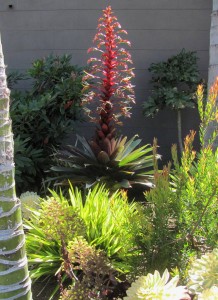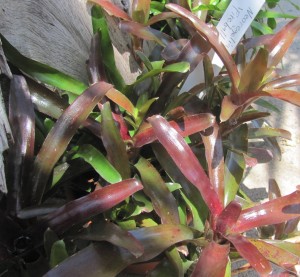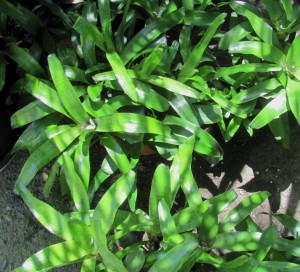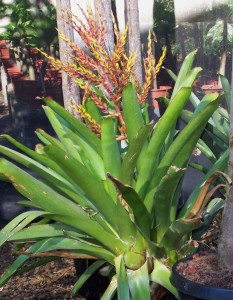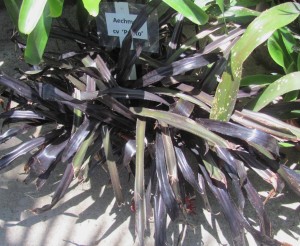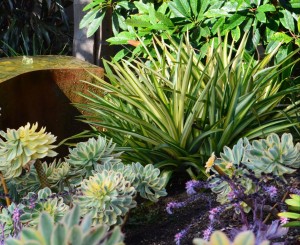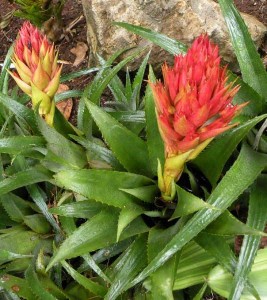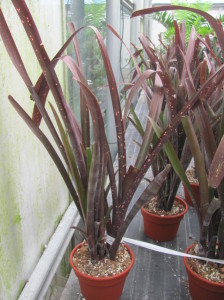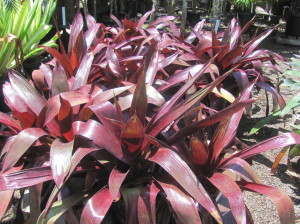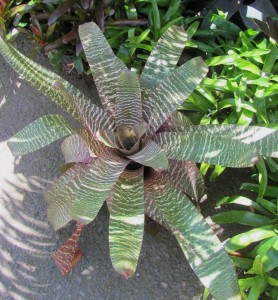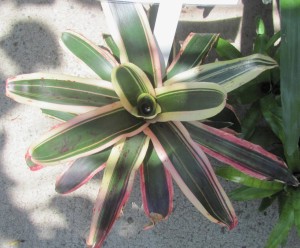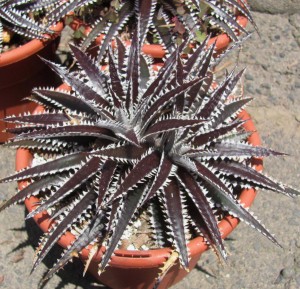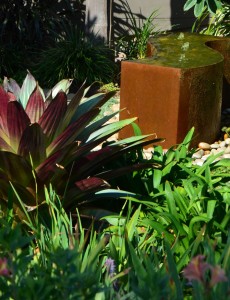 In my previous post I wrote about terrestrial bromeliads, a group of plants that can make beautiful, even majestic attention-grabbers in your garden while being perfect companions to many drought resistant plants. Their form, foliage and colors lend themselves very well to be paired with succulents, cacti and other low water plants in the sustainable landscape design.
In my previous post I wrote about terrestrial bromeliads, a group of plants that can make beautiful, even majestic attention-grabbers in your garden while being perfect companions to many drought resistant plants. Their form, foliage and colors lend themselves very well to be paired with succulents, cacti and other low water plants in the sustainable landscape design.
Bromeliads can be attractive specimen in the difficult areas of your garden, such as in hot reflected light or one that hardly sees any as on the north side of a house, under the eaves.
With this ability to do double-duty they can therefore be a great help with the tough spots when you design your landscape.
They all prefer these growing conditions:
- Good drainage
- Overhead watering
- Full sun or partial to full shade
- Frost resistant to about 20°
- Resistant to salt spray
- Low in fertilizer needs (which will speed up the growth at the expense of some of the leaf color; in general it will make the leaves greener)
- Moderate watering: overhead; 1x/week, sometimes more in hot weather (or hotter location, as an inland valley); 1x/month in cooler areas
Some noteworthy peculiarities of the bromeliads:
Most of the bromeliads that people grow only bloom a single time; some re-bloom. (The process is explained in detail at the site of the Bromeliad Society International.)
However, it can take years before they reach maturity and bloom; some produce flowers that stay on the plant for months or even years. Some grow “pups” or “offsets” before bloom; others grow these after the mother plant is done blooming and can now direct “her” energy into producing pups (some bromeliads also grow seeds). So for the one mother plant, you’ll probably end up with between 2 and 5 smaller plants once bloom has finished,.
These offsets can be cut or dug up and re-potted. For some of the bromeliads, especially the larger Vrieseas, I’d suggest to buy a larger plant to replace the mother plant as it take a few years until the offsets have reached the parent’s size..”.
Here now are the ‘toughies’ that I was talking about and see whether you can’t find one that would bring pizzazz to your garden.
The Vriesea imperialis (now classified as Alcantarea) is regal bromeliad with leathery, green strappy leaves with a deep wine-red tinge to it that intensifies in the sun. It is spectacular plant even when not in bloom because of its perfect form that relies solely on its rosette, and is as such a good companion to a modern/contemporary design.
It will develop, with several years of growth, a giant rosette, 4 to 5 ft large. It can tolerate full sun, even in my Ramona valley, but also tolerates partial shade. (When the temps reach 100 ° consistently, it’s better to give it afternoon protection.)
When it has reached its mature size which can take several years, it produces a giant inflorescence (flower stalk) that reaches up to 10 ft into the air and lingers for 4-5 months.
The New Zealand site “Bromeliads online” says about the Vriesea imperialis:
“In the garden these stately plants are easy to grow and trouble free. They will grow in virtually any soil, but prefer free draining soil. Application of fertiliser will certainly get them growing faster and bigger, but a reduction in leaf colour in the red types may result. They are completely resistant to salt spray and wind, coping with near cyclone conditions even when planted in an exposed position. They are surprisingly cold hardy, coping with up to frosts of several degrees. However young plants may be frost burnt. Full sun produces the best leaf colour and form, even with the green types. In tropical conditions some burning may occur in the middle of summer, but in temperate climates burning is rare, unless the plants have not been acclimatised before planting out.”
Here are more bromeliads for the full sun:
More bromeliads for the sun are the red Neoregelia ‘compacta’ and Neoregelia ‘Fireball’; they won’t get bigger than 1-2 ft wide and tall, and it’s the sun that brings out their red coloration, but they can also tolerate partial shade (which will make them greener).
Neoregelia pauciflora is nice and apple green that stays the same in sun or shade in cooler/more moderate climates; in a hot inland valley it will probably prefer the dappled shade under a tree – you might find it’s worth a try in your location.
For these bromeliads applies that the sun brings out their coloration. They can reach up to 2 ft across, spreading slowly by “offsets” (called “pups” with succulents) their flowers are short in the cup. They have most spectacular colorful foliage.
The Aechmea blanchetiana is a striking one with its apple-green foliage forming a rosette, up to 2-3 ft tall and 3-4 ft wide, slowly widening. Its “sister’ Aechmea blanchetiana ‘Tangerine’ will intensify its orange hues with more sun exposure.
The Aechmea cv. ‘Prietro’ is a bromeliad with almost black foliage black that produces striking orange red flowers. This would make a great companion to purple or chartreuse and yellow succulents, and it likes the full sun. Size: smallish, 15-18 inches tall, by 18×18 inches wide.
Aechmea comata ‘Lemon Lime‘: This is one that can take any exposure and has the perfect size of 2-3 ft x 2-3 ft.
Aechmea recurvata, another one for the sun, short 1-2 f x 1-2 ft. Beautiful and striking when planted in masses.
The Bilgerbia Baton Rouge is one for the worst sites: heat (even reflected), sunny. It can therefore be easily paired with cacti and some succulents. It will grow with vase-shaped rosettes that are about 12 inches across and to 24-30″ tall, and will slowly form an ever widening clump.
SHADE bromeliads
The Vriesea sanguinolenta is also a stately plant. This one prefers the dappled shade. It can grow to 3 x 3 ft.
The Vriesea fosteriana is another interesting one,with its marbled strappy leaves. It forms a rosette to 2-3 ft large.
Here’s one that can do both: Shade or sun. Is the modest sized Neoregelia ‘Magic Star Mint’. Its size is 1-2 ft x 1-2 ft (with slowly ever widening clumps).
From the Bromeliad family: Dyckia fosteriana hybrids ‘Brittlestar‘. It’s suitable for bright light, full sun or shade. Dyckias are succulents from the bromeliad family that form small clumps to about 8 inches by 8 inches, slowly widening, that bloom with orange flowers on a 2-3 upright, slightly branching inflorescence (here: flower stalk). With stiff and thorny leaves, prefer rocky and/or sunny areas and have a natural tendency to clump leading to thick, large mats. It’s cold hardy to 20-25 °.
Don’t forget that all these bromeliads are un-demanding in their water-needs and fit beautifully into xeriscape designs.
I thank Eric from Rancho Soledad and deeply appreciate his generous help with this article!
